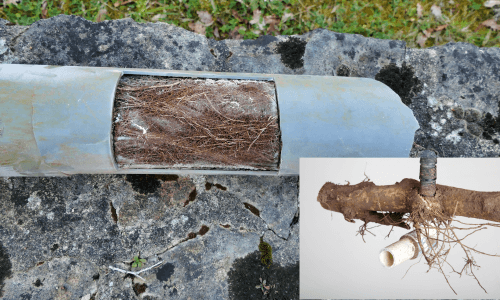
9 Ways to Avoid Tree Roots in Your Pipes (The Ultimate Guide!)
Tree roots invading underground pipes are a common problem faced by homeowners, leading to costly repairs and inconvenience. As experts at Local Plumber with years of experience in dealing with such issues, we understand the importance of preventive measures to avoid these problems. In this comprehensive guide, we will explain nine effective strategies to help homeowners prevent tree roots from damaging their pipes.-
Choose the Right Trees for Your Landscape:
When selecting trees, prioritize species known for their slow growth and shallow root systems. Japanese Maple (Acer palmatum), Dogwood (Cornus florida), and Cherry Trees (Prunus spp.) are excellent choices due to their fibrous, horizontally spreading roots that are less likely to interfere with underground utilities. These trees not only provide aesthetic value but also pose minimal risk to pipes.
Consider the local climate and soil conditions when choosing trees for your landscape. Native species are often well-adapted to the local environment and may require less maintenance compared to exotic varieties. Consult with local arborists or nurseries to select trees that thrive in your area and are less likely to cause problems for underground pipes.
Proper maintenance of trees is essential to prevent root intrusion. Water trees deeply and infrequently to encourage deep root growth and discourage roots from seeking moisture from pipes. Regular pruning can also help manage tree growth and reduce the risk of root damage to underground utilities.
Selecting the right trees for your landscape is a proactive measure to avoid tree roots in your pipes. Choose trees with non-invasive root systems, consider local climate and soil conditions, and maintain trees properly to minimize the risk of root intrusion. By investing in thoughtful tree selection and maintenance, homeowners can protect their underground pipes and enjoy a beautiful, functional landscape for years to come.
-
Strategic Placement of Trees:
When planning the placement of trees in your landscape, it’s essential to maintain a safe distance between trees and underground pipes. As a general rule, trees should be planted at least 10 to 20 feet away from utility lines to prevent roots from encroaching on pipes. However, the specific distance may vary depending on the type of tree, soil conditions, and the depth of underground utilities.
Avoid planting trees directly above or adjacent to sewer lines, as tree roots are naturally attracted to sources of moisture and nutrients. Instead, position trees strategically to minimize the risk of root intrusion. Consider the mature size of trees and their root spread when determining their placement in your landscape.
Additionally, consider the potential impact of tree roots on other underground structures, such as water supply lines and foundation footings. Planting trees too close to these structures can lead to root damage and compromise their stability. Be mindful of existing underground infrastructure when selecting locations for tree planting.
Removing Tree Roots In Sewer Line Near Me
In some cases, it may be necessary to install physical barriers or root barriers to prevent tree roots from reaching underground pipes. These barriers are typically made of durable materials such as plastic or metal and are installed underground between trees and pipes to block root growth. Proper installation of root barriers can effectively deter roots from encroaching into pipes and causing damage.Regular inspection and maintenance of underground pipes are also essential for early detection of root intrusion. Schedule annual inspections with a qualified plumber to check for signs of root infiltration, such as slow drains, gurgling noises, or foul odors emanating from drains. Timely detection can prevent extensive damage to pipes and minimize the need for costly repairs.
Tree Root Removal
Therefore, strategic placement of trees is vital for avoiding tree roots in your pipes. By maintaining a safe distance between trees and underground utilities, installing root barriers when necessary, and conducting regular inspections, homeowners can protect their plumbing infrastructure and preserve the health and beauty of their landscape.-
Regular Inspection and Maintenance:
Schedule annual inspections with a qualified plumber to assess the condition of your plumbing system. During these inspections, the plumber will inspect the pipes for signs of root infiltration, such as slow drains, gurgling noises, or foul odors emanating from drains. They may also use specialized equipment such as video cameras to inspect the interior of the pipes and identify any root intrusion.
Timely detection of root intrusion is crucial for preventing further damage to pipes. If roots are detected during the inspection, the plumber can take appropriate measures to remove them and restore proper drainage. This may involve using hydro-jetting or mechanical augers to clear roots from the pipes without causing damage.
In addition to annual inspections, homeowners should be vigilant for signs of root intrusion between scheduled maintenance visits. If you notice any warning signs such as slow drains or unusual noises coming from your plumbing system, it’s essential to contact a plumber for a thorough inspection.
Proactive maintenance measures can also help prevent root intrusion into pipes. Avoid planting trees too close to underground utilities, and consider installing physical barriers or root barriers to block root growth towards pipes. Proper drainage practices, such as ensuring that your yard has adequate drainage and avoiding overwatering, can also help deter roots from seeking moisture from pipes.
By scheduling annual inspections, remaining vigilant for signs of root intrusion, and taking proactive measures to prevent root growth towards pipes, homeowners can protect their plumbing infrastructure and avoid costly repairs.
-
Install Physical Barriers:
By strategically placing physical barriers, homeowners can prevent roots from reaching the pipes, minimizing the risk of damage and costly repairs. Regular maintenance, including periodic inspections to check for any damage or deterioration, ensures the continued effectiveness of these barriers. When complemented with other preventive measures like selecting non-invasive tree species and maintaining proper drainage, installing physical barriers becomes a key component of protecting plumbing infrastructure from tree root intrusion.
-
Use Chemical Root Inhibitors:
Regular application of chemical root inhibitors helps to maintain the integrity of the plumbing system by deterring root intrusion. Homeowners can follow the manufacturer’s instructions for proper usage and dosage to ensure maximum effectiveness.
It’s important to note that while chemical root inhibitors can be a valuable preventive measure, they are not always a standalone solution. Combining their use with other strategies such as regular inspections, proper drainage practices, and strategic tree placement can provide comprehensive protection against root damage to pipes.
Consulting with a qualified plumber or landscaping professional can provide further guidance on selecting and applying chemical root inhibitors effectively. By incorporating these inhibitors into their maintenance routine, homeowners can minimize the risk of tree root intrusion and prolong the lifespan of their plumbing infrastructure.
-
Implement Proper Drainage Practices:
Firstly, ensure that your yard has proper grading to prevent water from pooling near underground pipes. Proper grading encourages water to flow away from the area, reducing the attractiveness of pipes as a water source for tree roots.
Additionally, avoid overwatering your lawn and landscaping, as excessive moisture can stimulate root growth towards pipes. Water deeply but infrequently to encourage deep root growth away from underground utilities. Mulching around trees and plants can also help retain soil moisture and discourage root growth towards pipes. However, be mindful not to overmulch, as this can create excessively moist conditions that attract roots.
Regularly monitor your drainage system for any signs of leaks or blockages, as these can create conditions that attract tree roots. Address any issues promptly to prevent root intrusion into pipes. By implementing proper drainage practices, homeowners can minimize the risk of tree roots damaging underground pipes and maintain the integrity of their plumbing infrastructure.
-
Consider Non-Invasive Pipe Materials:
HDPE pipes are durable and flexible, making them less susceptible to damage from root intrusion compared to traditional materials like clay or concrete. Their smooth inner surface minimizes friction, reducing the likelihood of roots adhering to the pipe walls.
Similarly, PVC pipes offer excellent resistance to root penetration and corrosion. Their lightweight construction and smooth interior surface make them an ideal choice for underground installations, providing long-term protection against root intrusion.
By opting for non-invasive pipe materials, homeowners can significantly reduce the risk of tree roots damaging underground pipes. These durable and resistant materials not only help preserve the integrity of the plumbing system but also minimize the need for costly repairs and maintenance associated with root intrusion. Consulting with a qualified plumber or contractor can provide guidance on selecting the most suitable pipe materials for specific soil conditions and environmental factors.
-
Professional Root Removal:
By removing tree roots from pipes, this service restores proper drainage and prevents further damage to the plumbing system. It also helps minimize the risk of sewage backups, foul odors, and costly repairs associated with root intrusion.
Regular root removal maintenance is essential for homeowners to prevent root-related plumbing issues. Scheduling periodic root removal services can proactively address root intrusion and prolong the lifespan of underground pipes. Consulting with a qualified plumber for professional root removal ensures thorough and effective treatment, safeguarding the integrity of the plumbing infrastructure.
-
Tree Roots Removal as a Last Resort:
Before resorting to tree removal, homeowners should assess the health and significance of the tree in their landscape. Consulting with a certified arborist can help evaluate the tree’s condition, its importance to the ecosystem, and potential alternatives to removal.
If tree removal is deemed necessary, it should be performed by a qualified professional to ensure safety and minimize environmental impact. Additionally, homeowners should consider replanting with non-invasive tree species in a more suitable location away from underground utilities.
While tree removal is a drastic step, it may be the most effective solution to protect underground pipes and prevent future root-related damage. By carefully considering all options and seeking expert advice, homeowners can make informed decisions to preserve both their plumbing infrastructure and the natural beauty of their landscape.
Preventing tree roots from damaging underground pipes requires a combination of proactive measures, regular maintenance, and timely interventions. By implementing the nine strategies outlined in this guide, homeowners can minimize the risk of root intrusion and safeguard their plumbing systems. Remember to consult with a local plumber for personalized advice and professional assistance in addressing root-related issues effectively. With proper care and attention, you can maintain a healthy plumbing system and enjoy a thriving landscape for years to come.
Get in touch with us today for a quote and let us handle all your plumbing needs. Email us at services@local-plumber.com or call us at 813-776-7667 (POOP).





Leave a comment